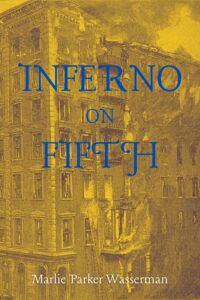I’m welcoming back Marlie Wasserman, historical fiction crime writer, who has a wonderful new book out from Level Best Books. Her new novel is inspired by an 1899 New York City fire at a luxury hotel in Manhattan.
 Historical crime fiction includes both novels set in a particular place and era, with an imagined crime, and novels closely tied to an actual crime in that time and place. Novelists writing in the latter category often describe their books as “inspired by true events.” My new novel, Inferno on Fifth, fits this “inspired by” category. I stay close to actual events and crimes, filling in blanks in the historical record and imagining the emotions of people caught up in those events.
Historical crime fiction includes both novels set in a particular place and era, with an imagined crime, and novels closely tied to an actual crime in that time and place. Novelists writing in the latter category often describe their books as “inspired by true events.” My new novel, Inferno on Fifth, fits this “inspired by” category. I stay close to actual events and crimes, filling in blanks in the historical record and imagining the emotions of people caught up in those events.
When I decided to write about the deathly 1899 fire in a luxurious Manhattan hotel named the Windsor, I began by reading New York City newspapers. Stories about the fire started on their front pages and continued for more pages, listing the survivors, the injured, the missing, and the dead—hundreds of them. I researched the people in each list, trying to imagine who knew whom, why each person happened to stay at the Windsor, and what each might have thought and felt in the midst of the fire.
Which of these characters would drive my plot? Eventually, I chose six women to tell the story. But I can’t stop thinking about all the other guests and servants at the hotel who lived through the ordeal but did not make the cut for my novel.
In the end, I included a few of these people in subplots, but I could devote only a limited number of scenes to their characters and actions. I wish I could have developed their stories further, so I am going to use this guest post to add depth to my characterizations of two of the hotel guests, a cad named William Earle Dodge Stokes, and his stylish wife, who had an even longer name—Rita Hernandez de Alba de Acosta Stokes Lydig. I focused on the couple in a few chapters, but they merit more space. Mr. Stokes was a wealthy real estate developer whose most famous project still stands. Readers, if you have spent time on New York’s Upper West Side, you have probably noticed the Ansonia, an enormous, ornate apartment building at 2109 Broadway, between 73rd and 74th. You will either love or hate its over-the-top architecture—turrets, cupolas, and a mansard roof. Now a condo, the building is on the National Register of Historic Places. Babe Ruth and Angelica Jolie, along with dozens of other celebrities, once lived there. At the time of the Windsor fire, Stokes began to work on the Ansonia. He also began to build a new home for himself and his wife, so he took rooms at the Windsor during the construction. 1899 was not a happy year for the couple. Reporters sniffed out plans for a divorce, hardly surprising since Stokes was known as an adulterer. In my novel, I describe him sneaking around in inappropriate activities while the fire rages. As for Mrs. Stokes, she has her own stories to tell. She was reportedly gorgeous, led an extravagant lifestyle, and hobnobbed with celebrated artists and intellectuals. One of her four sisters was Mercedes de Acosta, a lover of Greta Garbo.
Someday I would like to add texture and motive to the stories of a few other notable hotel guests who make only cameo appearances in my novel. These guests include Abner McKinley, the profiteering brother of President McKinley; Elbridge Gerry, the grandson of the Gerry who unintentionally lent his name to gerrymandering; and Arther Fuller, who supposedly offered $1000 to anyone who would rescue his wife from the flames. After telling those tales, maybe I’ll get to the notable guests who did not even make the cut for my subplots. These include young Isadora Duncan who was in the hotel on that fateful day, celebrated astrologist Evangeline Adams, and Confederate General John Cox Underwood. Critics urge novelists to kill their darlings, in other words, to eliminate from their stories any extraneous material, but when that material consists of men and women who either lived through or died in a raging inferno, it is tough to cast them aside.
St. Patrick’s Day, New York City, 1899. Spectators along Fifth Avenue, unaware of impending doom, enjoy the parade and the bands playing Irish tunes. Suddenly marchers halt at the immense and luxurious Windsor Hotel, watching terrified women at upper-floor windows cringe at the flames—and then leap. Within two hours, the fire kills close to one hundred people.
What set it off? An ember from a cigar? Robbers who sparked the fire as a distraction? Broken boilers in the basement?
Spunky hotel guest Marguerite Wells decides she and her two wealthy friends can discover what started the terrible inferno while three newly jobless hotel maids struggle to figure out how they can survive.
Inspired by the true story of the shocking fire that leveled one of Manhattan’s elegant hotels twelve years before the infamous Triangle Shirtwaist Factory fire, Inferno on Fifth prompts readers to ask how they would react in the defining seconds of an irreversible tragedy.
Buy Links:
You can find Marlie on Social Media at these sites:


This novel sounds fascinating. I was glued to the screen reading about the rejected characters.